Symmetry-Breaking-Induced Internal Mixing Enhancement of Droplet Collision
Abstract
:1. Introduction
2. Symmetric Collision between Two Identical Droplets
3. Symmetry-Preserving Methods for Binary Droplet Collision
4. Symmetry Breaking between Two Droplets of Unequal Sizes
5. Collision between Two Different Droplets
6. Internal Mixing Enhancement by Non-Newtonian Effects
7. Spin Effects on Droplet Collision and Internal Mixing
8. Conclusions
Author Contributions
Funding
Conflicts of Interest
References
- Low, T.B.; Collision, R.L. coalescence and breakup of raindrops. Part II: Parameterization of fragment size distribution. J. Atmos. Sci. 1982, 39, 1607–1618. [Google Scholar] [CrossRef]
- Villermaux, E.; Bossa, B. Single-drop fragmentation determines size distribution of raindrops. Nat. Phys. 2009, 5, 697. [Google Scholar] [CrossRef]
- Villermaux, E.; Bossa, B. Size distribution of raindrops. Nat. Phys. 2010, 6, 232. [Google Scholar] [CrossRef]
- Jiang, Y.; Umemura, A.; Law, C. An experimental investigation on the collision behaviour of hydrocarbon droplets. J. Fluid Mech. 1992, 234, 171–190. [Google Scholar] [CrossRef]
- Qian, J.; Law, C.K. Regimes of coalescence and separation in droplet collision. J. Fluid Mech. 1997, 331, 59–80. [Google Scholar] [CrossRef]
- Sirignano, W.A. Fluid Dynamics and Transport of Droplets and Sprays; Cambridge University Press: Cambridge, UK, 2010. [Google Scholar]
- Moreira, A.; Moita, A.; Panao, M. Advances and challenges in explaining fuel spray impingement: How much of single droplet impact research is useful? Prog. Energy Combust. Sci. 2010, 36, 554–580. [Google Scholar] [CrossRef]
- Taskiran, O.O.; Ergeneman, M. Trajectory based droplet collision model for spray modeling. Fuel 2014, 115, 896–900. [Google Scholar] [CrossRef]
- Lasheras, J.C.; Hopfinger, E. Liquid jet instability and atomization in a coaxial gas stream. Annu. Rev. Fluid Mech. 2000, 32, 275–308. [Google Scholar] [CrossRef]
- Varga, C.M.; Lasheras, J.C.; Hopfinger, E.J. Initial breakup of a small-diameter liquid jet by a high-speed gas stream. J. Fluid Mech. 2003, 497, 405–434. [Google Scholar] [CrossRef]
- Eggers, J.; Villermaux, E. Physics of liquid jets. Rep. Prog. Phys. 2008, 71, 036601. [Google Scholar] [CrossRef]
- Bush, J.W.; Hasha, A.E. On the collision of laminar jets: Fluid chains and fishbones. J. Fluid Mech. 2004, 511, 285–310. [Google Scholar] [CrossRef]
- Chen, X.; Ma, D.; Yang, V.; Popinet, S. High-fidelity simulations of impinging jet atomization. At. Sprays 2013, 23, 1079–1101. [Google Scholar] [CrossRef]
- Li, M.; Saha, A.; Zhu, D.; Sun, C.; Law, C.K. Dynamics of bouncing-versus-merging response in jet collision. Phys. Rev. E 2015, 92, 023024. [Google Scholar] [CrossRef] [PubMed]
- Rodrigues, N.S.; Kulkarni, V.; Gao, J.; Chen, J.; Sojka, P.E. Spray formation and atomization characteristics of non-Newtonian impinging jets at high Carreau numbers. Int. J. Multiph. Flow 2018, 106, 280–295. [Google Scholar] [CrossRef]
- Brazier-Smith, P.R.; Jennings, S.G.; Latham, J. The interaction of falling water drops: Coalescence. Proc. R. Soc. Lond. Ser. A Math. Phys. Sci. 1972, 326, 393. [Google Scholar]
- Bradley, S.; Stow, C. Collisions between liquid drops. Philos. Trans. R. Soc. A 1978, 287, 635–675. [Google Scholar]
- Ashgriz, N.; Poo, J. Coalescence and separation in binary collisions of liquid drops. J. Fluid Mech. 1990, 221, 183–204. [Google Scholar] [CrossRef]
- Estrade, J.-P.; Carentz, H.; Lavergne, G.; Biscos, Y. Experimental investigation of dynamic binary collision of ethanol droplets–a model for droplet coalescence and bouncing. Int. J. Heat Fluid Flow 1999, 20, 486–491. [Google Scholar] [CrossRef]
- Gotaas, C.; Havelka, P.; Jakobsen, H.A.; Svendsen, H.F. Evaluation of the impact parameter in droplet-droplet collision experiments by the aliasing method. Phys. Fluids 2007, 19, 102105. [Google Scholar] [CrossRef]
- Pan, K.L.; Law, C.K.; Zhou, B. Experimental and mechanistic description of merging and bouncing in head-on binary droplet collision. J. Appl. Phys. 2008, 103, 064901. [Google Scholar] [CrossRef]
- Pan, K.L.; Chou, P.C.; Tseng, Y.J. Binary droplet collision at high Weber number. Phys. Rev. E 2009, 80, 036301. [Google Scholar] [CrossRef] [PubMed]
- Rabe, C.; Malet, J.; Feuillebois, F. Experimental investigation of water droplet binary collisions and description of outcomes with a symmetric Weber number. Phys. Fluids 2010, 22, 047101. [Google Scholar] [CrossRef]
- Tang, C.; Zhang, P.; Law, C.K. Bouncing, coalescence, and separation in head-on collision of unequal-size droplets. Phys. Fluids 2012, 24, 022101. [Google Scholar] [CrossRef]
- Finotello, G.; Padding, J.T.; Deen, N.G.; Jongsma, A.; Innings, F.; Kuipers, J. Effect of viscosity on droplet-droplet collisional interaction. Phys. Fluids 2017, 29, 067102. [Google Scholar] [CrossRef]
- Al-Dirawi, K.H.; Bayly, A.E. A new model for the bouncing regime boundary in binary droplet collisions. Phys. Fluids 2019, 31, 027105. [Google Scholar] [CrossRef]
- Hinterbichler, H.; Planchette, C.; Brenn, G. Ternary drop collisions. Exp. Fluids 2015, 56, 190. [Google Scholar] [CrossRef]
- Orme, M. Experiments on droplet collisions, bounce, coalescence and disruption. Prog. Energy Combust. Sci. 1997, 23, 65–79. [Google Scholar] [CrossRef]
- Brenn, G. Droplet collision. In Handbook of Atomization and Sprays; Ashgriz, N., Ed.; Springer: Berlin, Germany, 2011; pp. 157–181. [Google Scholar]
- Josserand, C.; Thoroddsen, S.T. Drop Impact on a Solid Surface. Annu. Rev. Fluid Mech. 2016, 48, 365–391. [Google Scholar] [CrossRef]
- Kavehpour, H.P. Coalescence of drops. Annu. Rev. Fluid Mech. 2015, 47, 245–268. [Google Scholar] [CrossRef]
- Post, S.L.; Abraham, J. Modeling the outcome of drop–drop collisions in Diesel sprays. Int. J. Multiph. Flow 2002, 28, 997–1019. [Google Scholar] [CrossRef]
- Sommerfeld, M.; Kuschel, M. Modelling droplet collision outcomes for different substances and viscosities. Exp. Fluids 2016, 57, 187. [Google Scholar] [CrossRef]
- Al-Dirawi, K.H.; Al-Ghaithi, K.H.; Sykes, T.C.; Castrejón-Pita, J.R.; Bayly, A.E. Inertial stretching separation in binary droplet collisions. J. Fluid Mech. 2021, 927, A9. [Google Scholar] [CrossRef]
- Al-Dirawi, K.H.; Bayly, A.E. An experimental study of binary collisions of miscible droplets with non-identical viscosities. Exp. Fluids 2020, 61, 50. [Google Scholar] [CrossRef]
- Huang, K.L.; Pan, K.L. Transitions of bouncing and coalescence in binary droplet collisions. J. Fluid Mech. 2021, 928, A7. [Google Scholar] [CrossRef]
- O’Rourke, P.J. Collective Drop Effects on Vaporizing Liquid Sprays; Los Alamos National Lab.: Los Alamos, NM, USA, 1981. [Google Scholar]
- Shlegel, N.; Tkachenko, P.; Strizhak, P. Influence of viscosity, surface and interfacial tensions on the liquid droplet collisions. Chem. Eng. Sci. 2020, 220, 115639. [Google Scholar] [CrossRef]
- Chen, X.; Ma, D.; Yang, V. Collision outcome and mass transfer of unequal-sized droplet collision. In Proceedings of the 50th AIAA Aerospace Sciences Meeting including the New Horizons Forum and Aerospace Exposition, Reston, VA, USA, 9–12 January 2012. [Google Scholar]
- Chen, X.; Yang, V. Thickness-based adaptive mesh refinement methods for multi-phase flow simulations with thin regions. J. Comput. Phys. 2014, 269, 22–39. [Google Scholar] [CrossRef]
- Chen, X.; Yang, V. Direct numerical simulation of multiscale flow physics of binary droplet collision. Phys. Fluids 2020, 32, 062103. [Google Scholar] [CrossRef]
- He, C.; Xia, X.; Zhang, P. Non-monotonic viscous dissipation of bouncing droplets undergoing off-center collision. Phys. Fluids 2019, 31, 052004. [Google Scholar] [CrossRef]
- He, C.; Yue, L.; Zhang, P. A computational model for spinning effects on post-collision velocities of bouncing droplets. At. Sprays 2021, 31, 43–61. [Google Scholar] [CrossRef]
- He, C.; Yue, L.; Zhang, P. Spin-affected reflexive and stretching separation of off-center droplet collision. Phys. Rev. Fluids 2022, 7, 013603. [Google Scholar] [CrossRef]
- Anilkumar, A.; Lee, C.; Wang, T. Surface-tension-induced mixing following coalescence of initially stationary drops. Phys. Fluids 1991, 3, 2587–2591. [Google Scholar] [CrossRef]
- Sun, K.; Zhang, P.; Jia, M.; Wang, T. Collision-induced jet-like mixing for droplets of unequal-sizes. Int. J. Heat Mass Transfer. 2018, 120, 218–227. [Google Scholar] [CrossRef]
- Xia, X.; He, C.; Yu, D.; Zhao, J.; Zhang, P. Vortex-ring-induced internal mixing upon the coalescence of initially stationary droplets. Phys. Rev. Fluids 2017, 2, 113607. [Google Scholar] [CrossRef]
- Zhang, D.; Yu, D.; Zhang, P.; Yuan, Y.; Yue, L.; Zhang, T.; Fan, X. Hypergolic ignition modulated by head-on collision, intermixing and convective cooling of binary droplets with varying sizes. Int. J. Heat Mass Transf. 2019, 139, 475–481. [Google Scholar] [CrossRef]
- Tang, C.; Zhao, J.; Zhang, P.; Law, C.K.; Huang, Z. Dynamics of internal jets in the merging of two droplets of unequal sizes. J. Fluid Mech. 2016, 795, 671–689. [Google Scholar] [CrossRef]
- Gach, P.C.; Iwai, K.; Kim, P.W.; Hillson, N.J.; Singh, A.K. Droplet microfluidics for synthetic biology. Lab Chip 2017, 17, 3388–3400. [Google Scholar] [CrossRef] [PubMed]
- Sohrabi, S.; Moraveji, M.K. Droplet microfluidics: Fundamentals and its advanced applications. RSC Adv. 2020, 10, 27560. [Google Scholar] [CrossRef] [PubMed]
- Dambach, E.M.; Solomon, Y.; Heister, S.D.; Pourpoint, T.L. Investigation into the Hypergolic Ignition Process Initiated by Low Weber Number Collisions. J. Propuls. Power 2013, 29, 331–338. [Google Scholar] [CrossRef]
- Davis, S.M.; Yilmaz, N. Advances in Hypergolic Propellants: Ignition, Hydrazine, and Hydrogen Peroxide Research. Adv. Aerosp. Eng. 2014, 2014, 1–9. [Google Scholar] [CrossRef]
- Forness, J.M.; Pourpoint, T.L.; Heister, S.D. Experimental Study of Impingement and Reaction of Hypergolic Droplets. In Proceedings of the 49th AIAA/ASME/SAE/ASEE Joint Propulsion Conference, San Jose, CA, USA, 15–17 July 2013. [Google Scholar]
- Solomon, Y.; DeFini, S.J.; Pourpoint, T.L.; Anderson, W.E. Gelled monomethyl hydrazine hypergolic droplet investigation. J. Propuls. Power 2012, 29, 79–86. [Google Scholar] [CrossRef]
- Wang, S.; Thynell, S.T.; Chowdhury, A. Experimental study on hypergolic interaction between N,N,N′,N′-tetramethylethylenediamine and nitric acid. Energy Fuels 2010, 24, 5320–5330. [Google Scholar] [CrossRef]
- Zhang, D.; Yu, D.; Yuan, Y.; Zhang, P.; Fan, X. Hypergolic ignition induced by head-on collision of bi-propellant droplets: Monoethanolamine-based fuel and hydrogen peroxide. Fuel 2023, 342, 127788. [Google Scholar] [CrossRef]
- Zhang, D.; Zhang, P.; Yuan, Y.; Zhang, T. Hypergolic ignition by head-on collision of N,N,N′,N′-tetramethylethylenediamine and white fuming nitric acid droplets. Combust. Flame 2016, 173, 276–287. [Google Scholar] [CrossRef]
- Zhang, D.; He, C.; Zhang, P.; Tang, C. Mass interminglement and hypergolic ignition of TMEDA and WFNA droplets by off-center collision. Combust. Flame 2018, 197, 276–289. [Google Scholar] [CrossRef]
- Finotello, G.; De, S.; Vrouwenvelder, J.C.; Padding, J.T.; Buist, K.A.; Jongsma, A.; Innings, F.; Kuipers, J. Experimental investigation of non-Newtonian droplet collisions: The role of extensional viscosity. Exp. Fluids 2018, 59, 113. [Google Scholar] [CrossRef]
- Testik, F.Y. Outcome regimes of binary raindrop collisions. Atmos. Res. 2009, 94, 389–399. [Google Scholar] [CrossRef]
- Testik, F.Y.; Barros, A.P.; Bliven, L. Toward a physical characterization of raindrop collision outcome regimes. J. Atmos. Sci. 2011, 68, 1097–1113. [Google Scholar] [CrossRef]
- Krishnan, K.; Loth, E. Effects of gas and droplet characteristics on drop-drop collision outcome regimes. Int. J. Multiph. Flow 2015, 77, 171–186. [Google Scholar] [CrossRef]
- Subramaniam, S. Lagrangian–Eulerian methods for multiphase flows. Prog. Energy Combust. Sci. 2013, 39, 215–245. [Google Scholar] [CrossRef]
- Sommerfeld, M.; Pasternak, L. Advances in modelling of binary droplet collision outcomes in sprays: A review of available knowledge. Int. J. Multiph. Flow 2019, 117, 182–205. [Google Scholar] [CrossRef]
- Sun, K.; Jia, F.; Zhang, P.; Shu, L.; Wang, T. Marangoni Effect in Bipropellant Droplet Mixing during Hypergolic Ignition. Phys. Rev. Appl. 2021, 15, 034076. [Google Scholar] [CrossRef]
- Sun, K.; Zhang, P.; Law, C.K.; Wang, T. Collision Dynamics and Internal Mixing of Droplets of Non-Newtonian Liquids. Phys. Rev. Appl. 2015, 4, 054013. [Google Scholar] [CrossRef]
- He, C.; Zhang, P. Nonaxisymmetric flow characteristics in head-on collision of spinning droplets. Phys. Rev. Fluids 2020, 5, 113601. [Google Scholar] [CrossRef]
- Önder, A.; Liu, P.L.-F. Deep learning of interfacial curvature: A symmetry-preserving approach for the volume of fluid method. J. Comput. Phys. 2023, 485, 112110. [Google Scholar] [CrossRef]
- Trias, F.X.; Lehmkuhl, O.; Oliva, A.; Pérez-Segarra, C.D.; Verstappen, R. Symmetry-preserving discretization of Navier–Stokes equations on collocated unstructured grids. J. Comput. Phys. 2014, 258, 246–267. [Google Scholar] [CrossRef]
- Nikolopoulos, N.; Nikas, K.-S.; Bergeles, G. A numerical investigation of central binary collision of droplets. Comput. Fluids 2009, 38, 1191–1202. [Google Scholar] [CrossRef]
- Moukalled, F.; Mangani, L.; Darwish, M. Implementation of boundary conditions in the finite-volume pressure-based method—Part I: Segregated solvers. Numer. Heat Transf. Part B Fundam. 2016, 69, 534–562. [Google Scholar] [CrossRef]
- Inamuro, T.; Tajima, S.; Ogino, F. Lattice Boltzmann simulation of droplet collision dynamics. Int. J. Heat Mass Transf. 2004, 47, 4649–4657. [Google Scholar] [CrossRef]
- Zhang, Y.R.; Jiang, X.Z.; Luo, K.H. Bounce regime of droplet collisions: A molecular dynamics study. J. Comput. Sci. 2016, 17, 457–462. [Google Scholar] [CrossRef]
- Zhang, F.H.; Li, E.Q.; Thoroddsen, S.T. Satellite Formation during Coalescence of Unequal Size Drops. Phys. Rev. Lett. 2009, 102, 104502. [Google Scholar] [CrossRef]
- Chen, R.H. Diesel–diesel and diesel–ethanol drop collisions. Appl. Therm. Eng. 2007, 27, 604–610. [Google Scholar] [CrossRef]
- Chen, R.H.; Chen, C.T. Collision between immiscible drops with large surface tension difference: Diesel oil and water. Exp. Fluids 2006, 41, 453–461. [Google Scholar] [CrossRef]
- Gao, T.C.; Chen, R.H.; Pu, J.Y.; Lin, T.H. Collision between an ethanol drop and a water drop. Exp. Fluids 2005, 38, 731–738. [Google Scholar] [CrossRef]
- Planchette, C.; Lorenceau, E.; Brenn, G. The onset of fragmentation in binary liquid drop collisions. J. Fluid Mech. 2012, 702, 5–25. [Google Scholar] [CrossRef]
- Roisman, I.V.; Planchette, C.; Lorenceau, E.; Brenn, G. Binary collisions of drops of immiscible liquids. J. Fluid Mech. 2012, 690, 512–535. [Google Scholar] [CrossRef]
- Planchette, C.; Lorenceau, E.; Brenn, G. Liquid encapsulation by binary collisions of immiscible liquid drops. Colloids Surf. A 2010, 365, 89–94. [Google Scholar] [CrossRef]
- Torza, S.; Mason, S. Coalescence of two immiscible liquid drops. Science 1969, 163, 813–814. [Google Scholar] [CrossRef]
- Focke, C.; Kuschel, M.; Sommerfeld, M.; Bothe, D. Collision between high and low viscosity droplets: Direct numerical simulations and experiments. Int. J. Multiph. Flow 2013, 56, 81–92. [Google Scholar] [CrossRef]
- Blanchette, F.; Messio, L.; Bush, J.W. The influence of surface tension gradients on drop coalescence. Phys. Fluids 2009, 21, 072107. [Google Scholar] [CrossRef]
- Sun, K.; Zhang, P.; Che, Z.; Wang, T. Marangoni-flow-induced partial coalescence of a droplet on a liquid/air interface. Phys. Rev. Fluids 2018, 3, 023602. [Google Scholar] [CrossRef]
- Pan, K.L.; Tseng, Y.H.; Chen, J.C.; Huang, K.L.; Wang, C.H.; Lai, M.C. Controlling droplet bouncing and coalescence with surfactant. J. Fluid Mech. 2016, 799, 603–636. [Google Scholar] [CrossRef]
- Blanchette, F. Simulation of mixing within drops due to surface tension variations. Phys. Rev. Lett. 2010, 105, 074501. [Google Scholar] [CrossRef] [PubMed]
- Wang, C.; Fu, S.; Kung, L.; Law, C. Combustion and microexplosion of collision-merged methanol/alkane droplets. Proc. Combust. Inst. 2005, 30, 1965–1972. [Google Scholar] [CrossRef]
- Nisisako, T. Recent advances in microfluidic production of Janus droplets and particles. Curr. Opin. Colloid Interface Sci. 2016, 25, 1–12. [Google Scholar] [CrossRef]
- Chen, X.; Yang, V. Dynamics of Non-Newtonian Liquid Droplet Collision. In Proceedings of the APS Meeting Abstracts 2012, Boston, MA, USA, 27 February–2 March 2012. [Google Scholar]
- Sun, K.; Wang, T.; Zhang, P.; Law, C.K. Non-Newtonian flow effects on the coalescence and mixing of initially stationary droplets of shear-thinning fluids. Phys. Rev. E 2015, 91, 023009. [Google Scholar] [CrossRef]
- Focke, C.; Bothe, D. Direct numerical simulation of binary off-center collisions of shear thinning droplets at high Weber numbers. Phys. Fluids 2012, 24, 073105. [Google Scholar] [CrossRef]
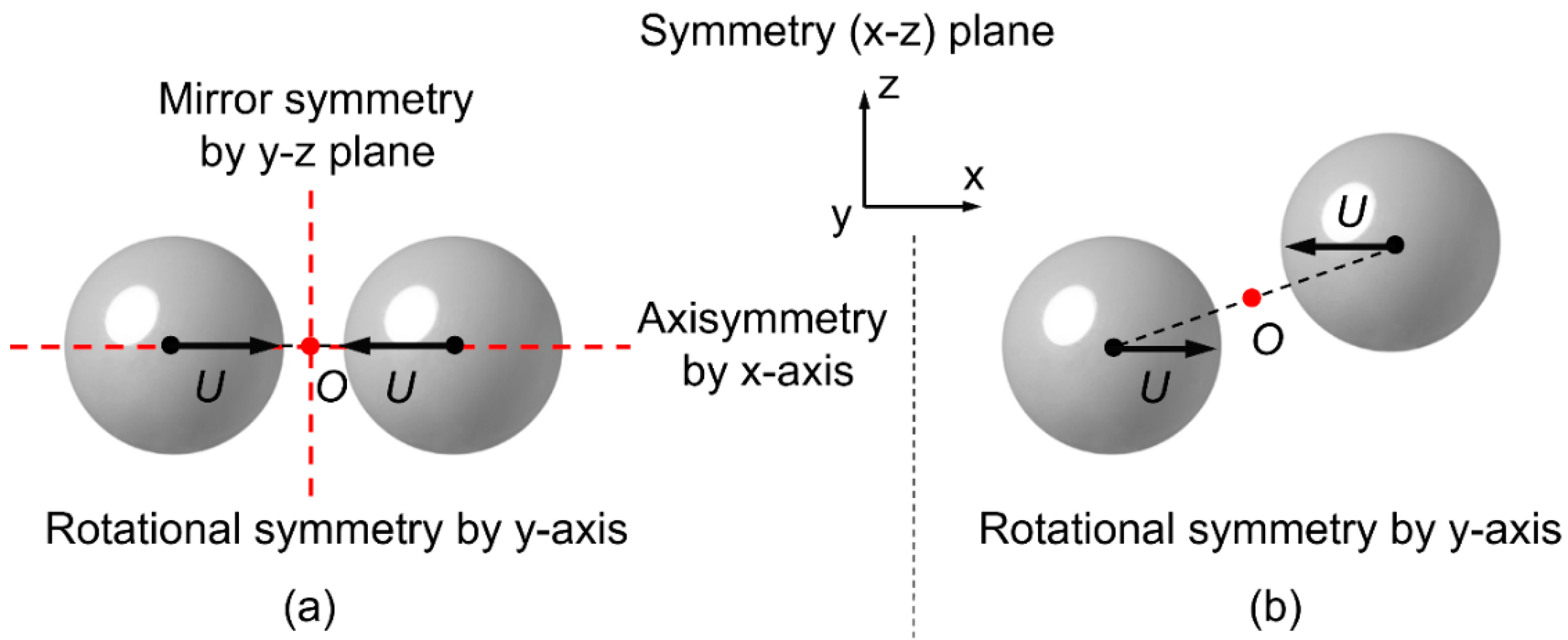

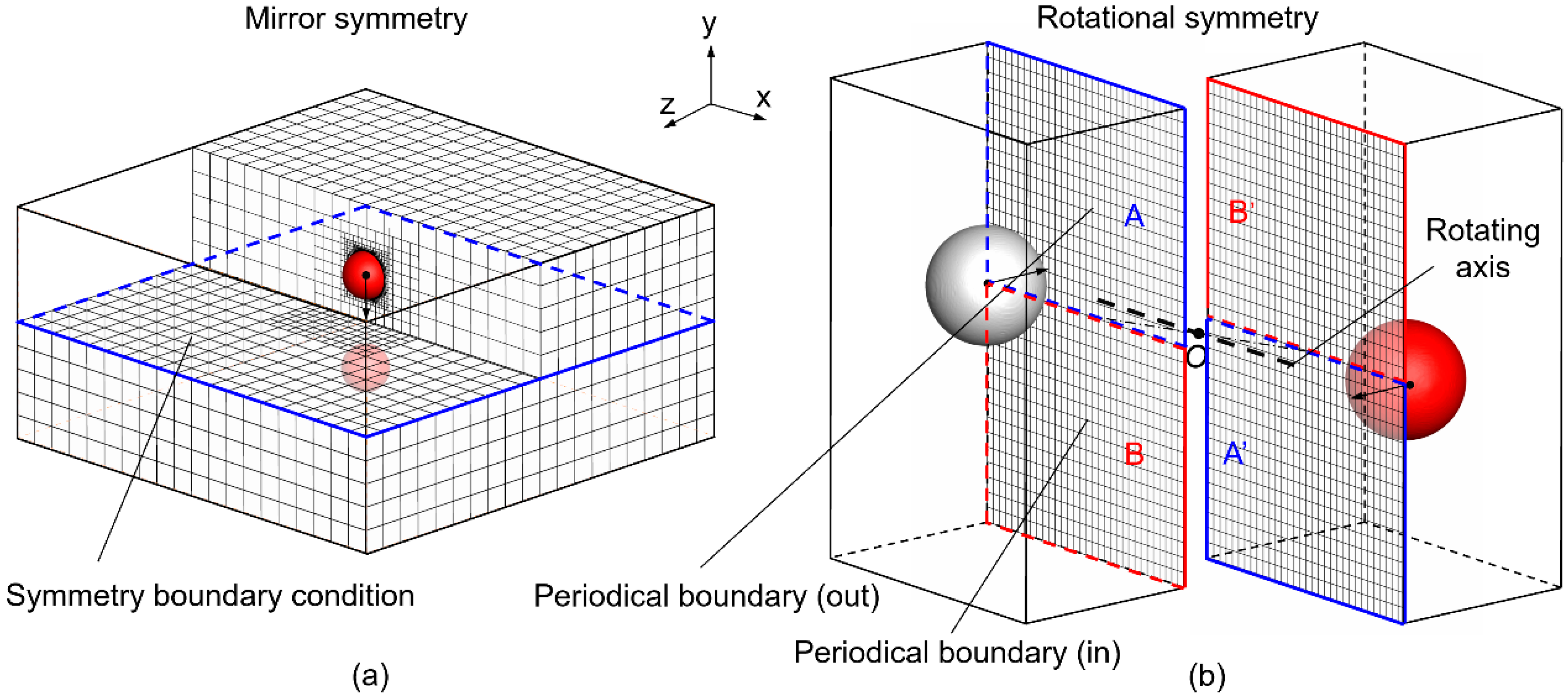
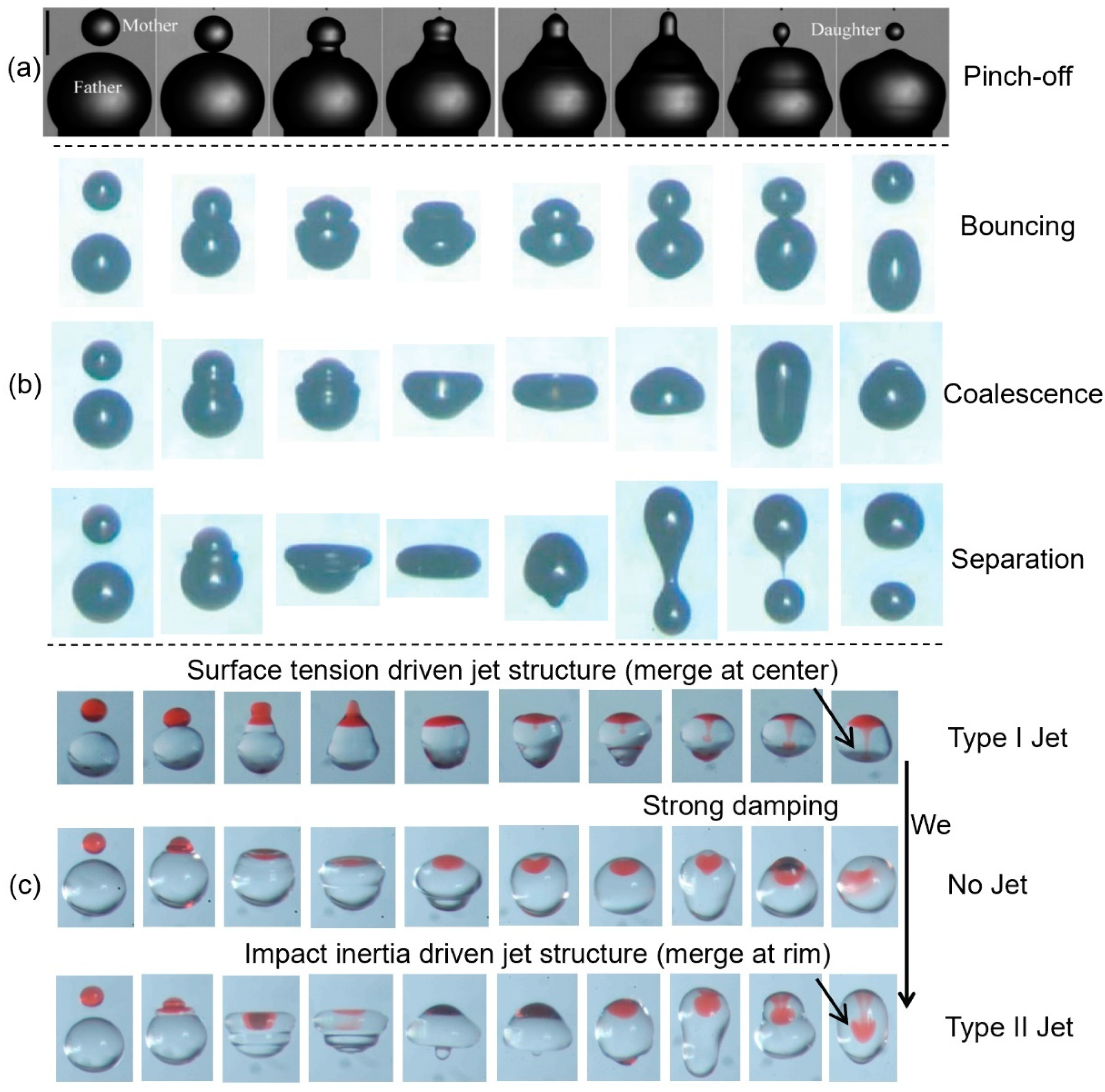
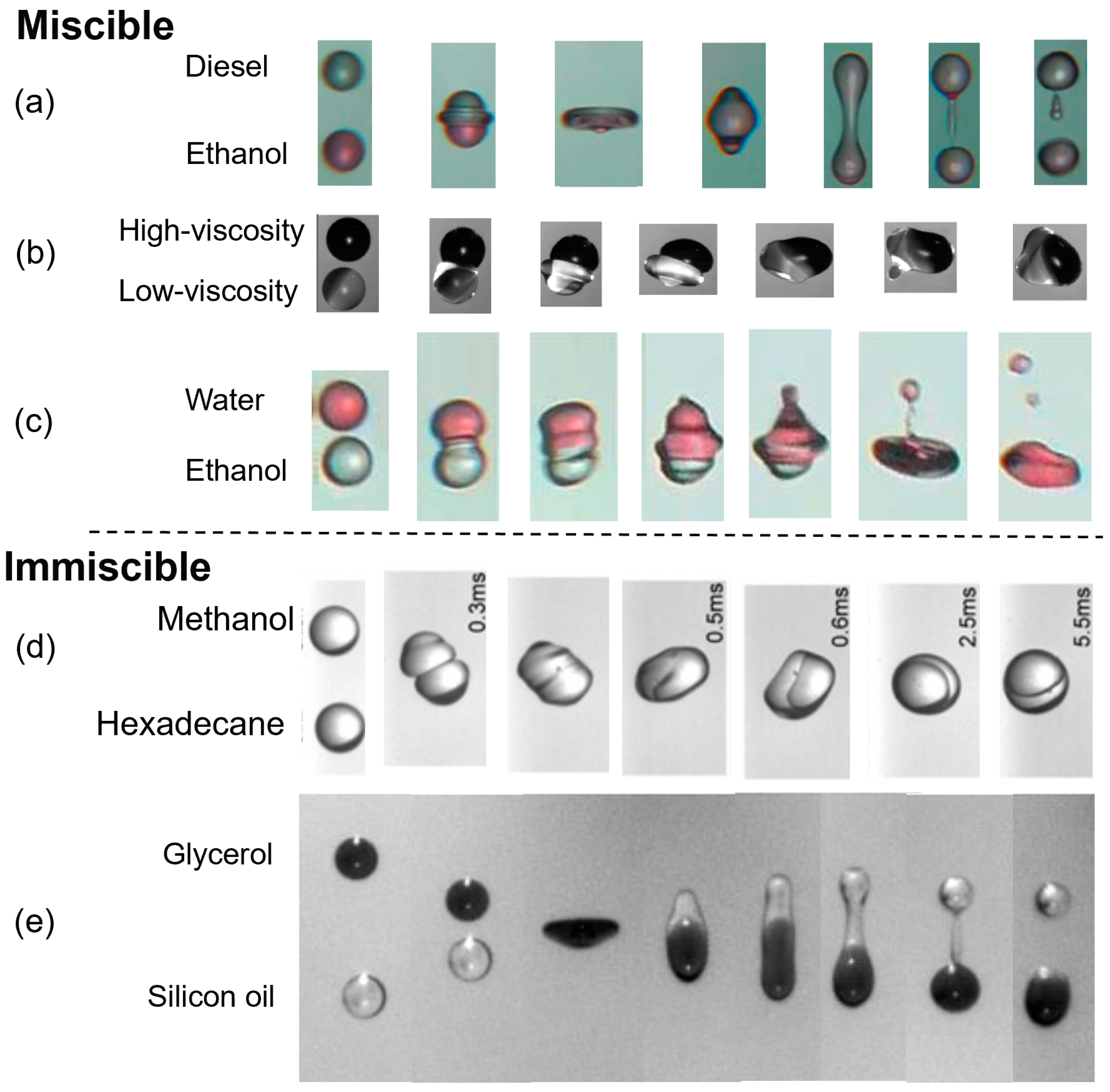

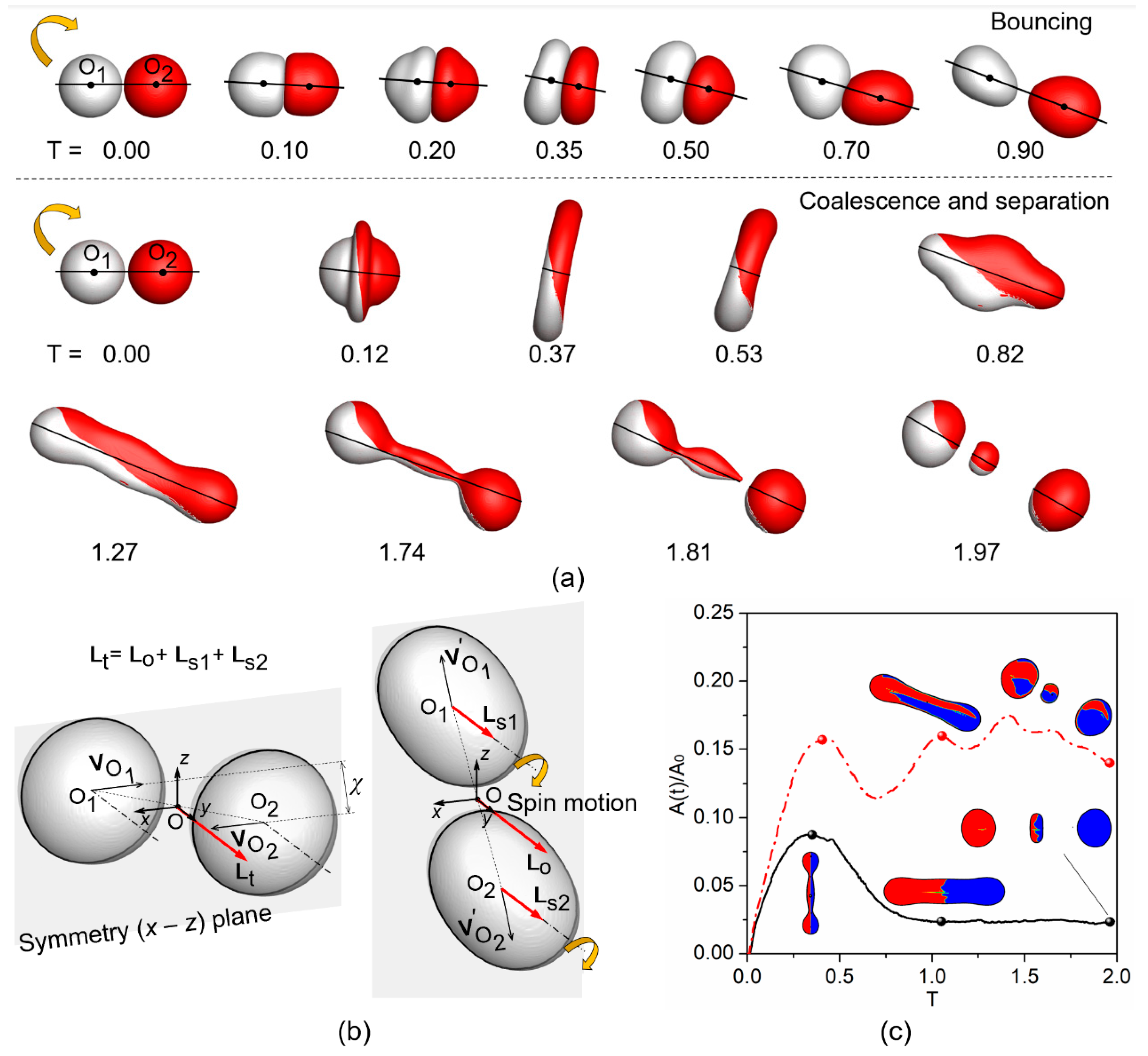
Disclaimer/Publisher’s Note: The statements, opinions and data contained in all publications are solely those of the individual author(s) and contributor(s) and not of MDPI and/or the editor(s). MDPI and/or the editor(s) disclaim responsibility for any injury to people or property resulting from any ideas, methods, instructions or products referred to in the content. |
© 2023 by the authors. Licensee MDPI, Basel, Switzerland. This article is an open access article distributed under the terms and conditions of the Creative Commons Attribution (CC BY) license (https://creativecommons.org/licenses/by/4.0/).
Share and Cite
Leng, Y.; He, C.; Wang, Q.; He, Z.; Simms, N.; Zhang, P. Symmetry-Breaking-Induced Internal Mixing Enhancement of Droplet Collision. Symmetry 2024, 16, 47. https://doi.org/10.3390/sym16010047
Leng Y, He C, Wang Q, He Z, Simms N, Zhang P. Symmetry-Breaking-Induced Internal Mixing Enhancement of Droplet Collision. Symmetry. 2024; 16(1):47. https://doi.org/10.3390/sym16010047
Chicago/Turabian StyleLeng, Yupeng, Chengming He, Qian Wang, Zhixia He, Nigel Simms, and Peng Zhang. 2024. "Symmetry-Breaking-Induced Internal Mixing Enhancement of Droplet Collision" Symmetry 16, no. 1: 47. https://doi.org/10.3390/sym16010047
APA StyleLeng, Y., He, C., Wang, Q., He, Z., Simms, N., & Zhang, P. (2024). Symmetry-Breaking-Induced Internal Mixing Enhancement of Droplet Collision. Symmetry, 16(1), 47. https://doi.org/10.3390/sym16010047







